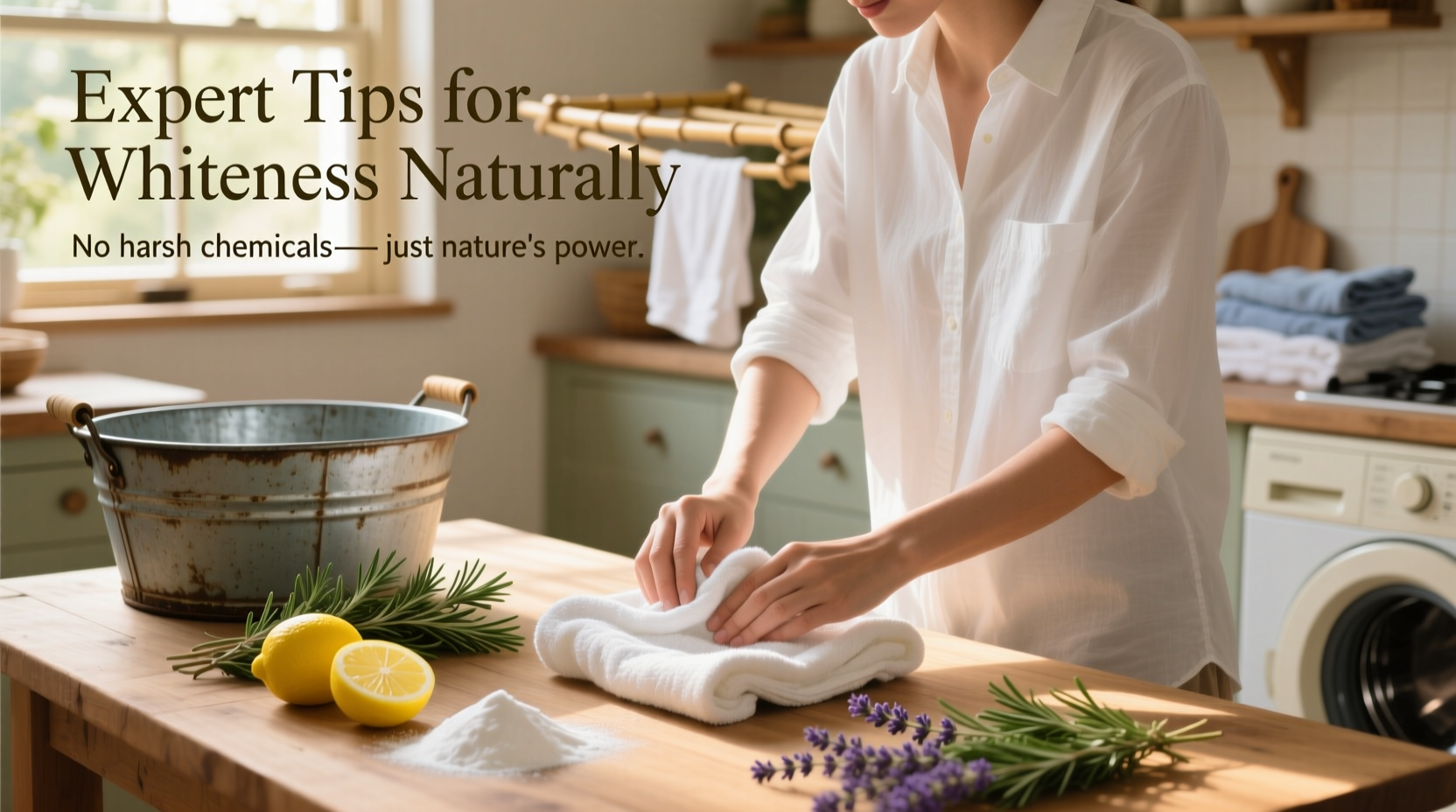Over time, white clothes lose their brightness. Sweat, body oils, detergent buildup, and environmental exposure cause whites to yellow or gray. While commercial bleach may offer a quick fix, it often damages fabrics, fades colors, and introduces harsh chemicals into your home. Fortunately, nature provides powerful alternatives that are gentle on fibers and tough on stains. With the right techniques, you can restore your whites—without compromising fabric integrity or indoor air quality.
The Science Behind Natural Whitening

Whitening isn’t about adding color—it’s about removing what dulls it. Yellowing occurs when organic residues bind to fabric fibers. Natural whitening agents work by breaking down these compounds through oxidation, pH adjustment, or enzymatic action. Sunlight, for example, emits ultraviolet (UV) radiation that breaks chemical bonds in stains, effectively bleaching them without chlorine. Ingredients like baking soda and hydrogen peroxide alter the water’s pH or release oxygen molecules to lift grime from fibers.
Unlike synthetic bleaches, natural methods typically require longer contact time but preserve fabric strength. Cotton, linen, and polyester blends respond well to these treatments when applied consistently. Delicate fabrics like silk or wool should be treated with extra caution—most natural whitening processes are too alkaline or oxidative for protein-based fibers.
Top 5 Natural Whitening Methods That Work
These time-tested methods use common household ingredients. Each has unique strengths depending on the type of discoloration and fabric.
- Sun Bleaching – The most effective natural whitener. UV rays break down organic stains. Hang damp white clothes directly in sunlight after washing. Rotate garments every 30 minutes for even exposure. Best for cotton towels, sheets, and t-shirts.
- Baking Soda + Vinegar Wash – Baking soda lifts stains and neutralizes odors; vinegar dissolves mineral deposits and soap scum. Add ½ cup baking soda to the drum before loading clothes. During the rinse cycle, add 1 cup white vinegar to the fabric softener dispenser.
- Hydrogen Peroxide Soak – A mild oxidizer that brightens without damaging most fabrics. Mix 1 cup of 3% hydrogen peroxide with warm water in a basin. Soak whites for 30–60 minutes before washing. Effective on underarm stains and food spills.
- Lemon Juice & Sun Method – Lemon juice contains citric acid, which acts as a natural bleach. Squeeze two lemons into a pot of hot water, soak clothes for 1 hour, then hang in direct sun. Rinse thoroughly afterward to prevent fiber weakening.
- Washing Soda Boost – Not the same as baking soda, washing soda (sodium carbonate) increases water alkalinity, helping to dissolve grease and suspend soil. Add ½ cup to your regular detergent during the wash cycle.
Step-by-Step Guide: Deep Whitening Routine
For heavily soiled or long-stored whites, follow this weekly deep-cleaning protocol:
- Sort clothes by fabric type and soil level. Separate heavily stained items.
- Pre-treat visible stains with a paste of baking soda and water. Let sit for 20 minutes.
- Fill a bathtub or large basin with hot water (check garment labels for temperature limits).
- Add 1 cup hydrogen peroxide, ½ cup baking soda, and ½ cup washing soda.
- Submerge clothes completely. Stir gently to ensure even saturation.
- Soak for 2–4 hours, or overnight for stubborn yellowing.
- Wash in machine using cold water and mild detergent. Do not mix with colored laundry.
- Line dry in direct sunlight if possible. Avoid dryer heat until fully stain-free.
This process removes embedded grime and resets fabric brightness. Repeat every 4–6 weeks for best results.
Do’s and Don’ts of Natural Whitening
| Do’s | Don’ts |
|---|---|
| Use distilled white vinegar (5% acidity) for optimal cleaning power | Never mix vinegar with hydrogen peroxide in the same cycle—creates corrosive peracetic acid |
| Expose clothes to sunlight immediately after washing for maximum UV effect | Avoid prolonged soaking in lemon juice—can weaken cotton over time |
| Rotate garments when sun-drying to prevent uneven fading | Don’t use metal containers for soaking—some ingredients react with metal |
| Store cleaned whites in breathable cotton bags away from humidity | Never store yellowed clothes untreated—stains set over time |
“Natural whitening isn’t instant, but it builds cumulative results. I recommend rotating between hydrogen peroxide soaks and solar drying for sustainable brightness.” — Dr. Lena Patel, Textile Chemist and Sustainable Laundry Consultant
Real Example: Reviving a Yellowed Wedding Shirt
Mark had stored his dress shirt from his brother’s wedding five years prior. When he retrieved it, the collar and cuffs were deeply yellowed. He avoided dry cleaning due to cost and chemical concerns. Instead, he followed the deep whitening routine: pre-treated with baking soda paste, soaked overnight in hydrogen peroxide and washing soda, then washed with vinegar in the rinse cycle. After two rounds of this process and three hours of sun drying, the shirt regained 90% of its original brightness. Mark now uses monthly sun-drying to maintain all his white dress shirts.
Frequently Asked Questions
Can I use these methods on colored clothes?
No. Natural whitening agents like hydrogen peroxide and lemon juice can lighten dyes. Stick to vinegar and baking soda only for colors, and always spot-test first.
Why do my whites turn gray instead of yellow?
Gray tones usually result from insufficient rinsing, detergent buildup, or washing too many clothes at once. Adding ½ cup vinegar to the rinse cycle helps remove residue and restore brightness.
How often should I deep-clean my whites?
Every 4–6 weeks is ideal for frequently worn items like undershirts or athletic wear. Less-used items like sheets or formalwear benefit from seasonal deep cleaning.
Checklist: Your Natural Whitening Action Plan
- ☐ Inspect all white garments for stains or yellowing
- ☐ Gather supplies: baking soda, hydrogen peroxide, white vinegar, washing soda, lemons
- ☐ Pre-treat high-soil areas (collars, armpits, cuffs)
- ☐ Soak in natural solution based on fabric type
- ☐ Wash with compatible detergent and vinegar rinse
- ☐ Dry in direct sunlight whenever possible
- ☐ Store clean whites in cool, dry, ventilated space
- ☐ Repeat deep cleaning monthly or bi-monthly
Maintaining Whiteness Between Washes
Prevention is more effective than correction. Wear undershirts to reduce sweat transfer. Change clothes promptly after workouts. Avoid deodorants with aluminum and dyes—they contribute significantly to underarm yellowing. When storing whites, use cedar blocks instead of mothballs, which leave a yellowish film. Rotate your wardrobe so no single item bears constant wear.
Washing habits matter. Overloading the machine reduces friction and rinsing efficiency. Underloading causes excessive agitation. Use the correct water temperature—hot enough to dissolve oils but not damage fibers. And never skip the rinse cycle; residual detergent clouds fabric appearance.
Conclusion
Whiter clothes don’t require toxic chemicals or expensive products. With sunlight, pantry staples, and consistent care, you can achieve brilliant results while extending the life of your garments. These natural methods are safer for your skin, your washing machine, and the environment. Start integrating one or two techniques this week—sun-dry a load, try a peroxide soak, or refresh your routine with vinegar. Small changes lead to lasting brightness.









 浙公网安备
33010002000092号
浙公网安备
33010002000092号 浙B2-20120091-4
浙B2-20120091-4
Comments
No comments yet. Why don't you start the discussion?